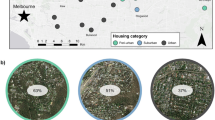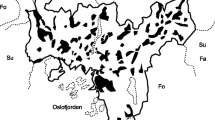Abstract
Estimating the relative importance of vegetation on residential land (gardens, yards, and street-trees) and vegetation on non-residential land (parks and other large green spaces) is important so that competing options for urban conservation planning can be prioritized. We used data from an urban breeding-bird monitoring program to compare the relative effects vegetation on residential land and vegetation on non-residential land (both the amount and type of vegetation at local and landscape scales) on bird species richness and an index of conservation value for the bird community. We then estimated the realised relative benefit of managing the amount of vegetation on these two types of land (i.e., as alternative management options for promoting biodiversity), which might be achieved within the practical limits imposed by human population density. The local effects of increasing residential and non-residential vegetation amount were similar and positive on all measures of bird species richness and conservation value. Non-residential vegetation had an additional landscape-scale influence on bird diversity that residential vegetation did not. Options for managing the amount of non-residential vegetation appear to be more limited by high human population density than for managing the amount of residential vegetation. This suggests that there may be greater realised benefits to bird diversity from managing the amount of vegetation on residential land than from the more common focus of urban planning of managing vegetation on non-residential land.





Similar content being viewed by others
References
Addicott JF, Aho JM, Antolin MF, Padilla DK, Richardson JS, Soluk DA (1987) Ecological neighborhoods: scaling environmental patterns. Oikos 49:340–346
Anderson DR, Burnham KP, Gould WR, Cherry S (2001) Concerns about finding effects that are actually spurious. Wildl Soc Bull 29:311–316
Arendt R (2004) Linked landscapes: creating greenway corridors through conservation subdivision design strategies in the northeastern and central United States. Landsc Urban Plan 68:241–269
Balmford A, Moore JL, Brooks T, Burgess N, Hansen LA, Williams P, Rahbek C (2001) Conservation conflicts across Africa. Science 291:2616
BivandR, Anselin L, Assunção R, Berke O, Bernat A, Blankmeyer E, Carvalho M, Chun Y, Christensen B, Dormann C, Dray S, Halbersma R, Krainski E, Lewin-Koh N, Li H, Ma J, Millo G, Mueller W, Ono H, Peres-Neto P, Piras G, Reder M, Tiefelsdorf M, Yu D (2010) spdep: Spatial dependence: weighting schemes, statistics and models R package version 0.4-58. http://CRAN.R-project.org/package=spdep
Blair R (1996) Land use and avian species diversity along an urban gradient. Ecol Appl 6:506–519
Burnham KP, Anderson DR (2002) Model selection and multi-model inference: A practical information–theoretic approach 2nd ed. Springer, New York
Chapman KA, Reich PB (2007) Land use and habitat gradients determine bird community diversity and abundance in suburban, rural and reserve landscapes of Minnesota, USA. Biol Conserv 135:527–541
Chase JF, Walsh JJ (2006) Urban effects on native avifauna. Landsc Urban Plan 74:46–69
Clergeau P, Savard JPL, Mennechez G, Falardeau G (1998) Bird abundance and diversity along an urban-rural gradient: a comparative study between two cities on different continents. Condor 100:413–425
Daniels GD, Kirkpatrick JB (2006) Does variation in garden characteristics influence the conservation of birds in suburbia? Biol Conserv 133:326–335
Deguise IE, Kerr JT (2006) Protected areas and prospects for endangered species conservation in Canada. Conserv Biol 20:48–55
R Development Core Team (2009) R: A language and environment for statistical computing R Foundation for Statistical Computing, Vienna, Austria ISBN 3-900051-07-0, URL http://www.R-project.org
Donnelly R, Marzluff JM (2004) Importance of reserve size and landscape context to urban bird conservation. Conserv Biol 18:733–745
Donnelly R, Marzluff JM (2006) Relative importance of habitat quantity, structure, and spatial pattern to birds in urbanizing environments. Urban Ecosyst 9:99–117
Ecological Stratification Working Group (1996) A national ecological framework for Canada - agriculture and agri-food Canada. Research Branch, Ottawa/Hull
Environment Canada (2007) Area-sensitive forest birds in urban areas Ontario: Environment Canada URL http://www.on.ec.gc.ca/wildlife
Evans KL, Newson SE, Gaston KJ (2009) Habitat influences on urban avian assemblages. Ibis 151:19–39
Farber S (2005) The economics of biodiversity in urbanizing ecosystems. In: Johnson EA, Klemens MW (eds) Nature in fragments. The Legacy of Sprawl Columbia University Press, New York
Farnsworth GL (2002) A removal model for estimating detection probabilities from point-count surveys. Auk 119:414–425
Fernandez-Juricic (2000) Avifaunal use of wooded streets in an urban landscape. Conserv Biol 14:513–521
Fernandez-Juricic E, Jokimaki J (2001) A habitat island approach to conserving birds in urban landscapes: case studies from southern and northern Europe. Biodivers Conserv 10:2023–2043
Fernandez-Juricic E, Telleria JL (2000) Effects of human disturbance on spatial and temporal feeding patterns of Blackbird Turdus merula in urban parks in Madrid, Spain. Bird Study 47:13–21
Gagne SA (2010) The trade-off between housing density and sprawl area: minimising impacts to forest breeding birds. Basic App Ecol 11:723–733
Gaston KJ, Warren PH, Thompson K, Smith RM (2005) Urban domestic gardens (IV): the extent of the resource and its features. Biodivers Conserv 14:3327–3349
Grace JB, Bollen KA (2005) Interpreting the results from multiple regression and structural equation models. Bull Ecol Soc Am 86:283–295
Griffith DA, Peres-Neto PR (2006) Spatial modeling in ecology: the flexibility of Eigenfunction spatial analyses. Ecology 87:2603–2613
Herrando S, Brotons L, Guallar S, Quesada J (2010) Assessing regional variation in conservation value using fine-grained bird atlases. Biodivers Conserv 19:867–881
Huggins RM (1989) On the statistical analysis of capture experiments. Biometrika 76:133–140
Jokimaki J, Suhonen J (1998) Distribution and habitat selection of wintering birds in urban environments. Landsc Urban Plan 39:253–263
Koenker RW (2005) Quantile Regression, Cambridge U. Press
Laake J (2010) RMark: R Code for MARK Analysis R package version 1.9.6
Lancaster RK, Rees WE (1979) Bird communities and the structure of urban habitats. Can J Zool 57:2358–2368
Lerman SB, Warren PS (2011) The conservation value of residential yards: linking birds and people. Ecol Appl 21:1327–1339
Marzluff JM, Ewing K (2001) Restoration of fragmented landscapes for the conservation of birds: a general framework and specific recommendations for urbanizing landscapes. Restor Ecol 9:280–292
McKinney ML (2006) Urbanization as a major cause of biotic homogenization. Biol Conserv 127:247–260
McKinney ML (2008) Effects of urbanization on species richness: a review of plants and animals. Urban Ecosyst 11:161–176
Melles S, Glenn S, Martin K (2003) Urban bird diversity and landscape complexity: species-environment associations along a multiscale habitat gradient. Conserv Ecol 7:22
Miller JR (2005) Biodiversity conservation and the extinction of experience. Trends Ecol Evol 20:430–434
Murgui E (2007) Factors influencing the bird community of urban wooded streets along an annual cycle. Ornis Fenn 84:66–77
Nilsson KL and Florgard C (2009) Ecological scientific knowledge in urban and land-use planning In Eds. McDonnell, MJ, AK Hahs, and JH Breuste Ecology of Cities and Towns: A Comparative Approach Cambridge University Press
Nuttle T, Leidolf A, Jr Burger LW (2003) Assessing conservation value of bird communities with partners in flight–based ranks. Auk 20:541–549
Panjabi AO, Dunn EH, Blancher PJ, Hunter WC, Altman B, Bart J, Beardmore CJ, Berlanga H, Butcher GS, Davis SK, Demarest DW, Dettmers R, Easton W, Gomez de Silva Garza H, Iñigo-Elias EE, Pashley DN, Ralph CJ, Rich TD, Rosenberg KV, Rustay CM, Ruth JM, Wendt JS, Will TC (2005) The Partners in Flight handbook on species assessment Version 2005 Partners in Flight Technical Series No. 3 Rocky Mountain Bird Observatory website: http://www.rmbo.org/pubs/downloads/Handbook2005.pdf
Peterjohn BG (1994) The North American Breeding Bird Survey. Birding 26:386–398
Rich TD, Beardmore CJ, Berlanga H, Blancher PJ, Bradstreet MSW, Butcher GS, Demarest DW, Dunn EH, Hunter WC, Inigo-Elias EE, Kennedy JA, Martell AM, Panjabi AO, Pashley DN, Rosenberg KV, Rustay CM, Wendt JS, Will TC (2004) Partners in flight North American landbird conservation plan. Cornell Lab of Ornithology, Ithaca
Rosenzweig ML (1995) Species diversity in space and time. Cambridge University Press, Cambridge
Schmiegelow FKA, Monkkonen M (2002) Habitat loss and fragmentation in dynamic landscapes: avian perspectives from the boreal forest. Ecol Appl 12:375–389
Smith RM, Gaston KJ, Warren PH, Thompson K (2005) Urban domestic gardens (V): relationships between landcover composition, housing and landscape. Landsc Ecol 20:235–253
Smith AC, Koper N, Francis CM, Fahrig L (2009) Confronting collinearity: comparing methods for disentangling the effects of habitat loss and fragmentation. Landsc Ecol 24:1271–1285
Smith AC, Francis CM, Fahrig L (2011) Landscape size affects the relative importance of habitat amount, habitat fragmentation, and matrix quality on forest birds. Ecography 34:103–113
Turner WR, Nakamura T, Dinetti M (2004) Global urbanization and the separation of humans from nature. Bioscience 54:585–590
van Heezik Y, Smyth A, Mathieu R (2008) Diversity of native and exotic birds across an urban gradient in a New Zealand city. Landsc Urban Plan 87:223–232
White GC, Burnham KP (1999) Program MARK: survival estimation from populations of marked animals. Bird Study 46 Supplement:120–138
White JG, Antos MJ, Fitzsimons JA, Palmer GC (2005) Non-uniform bird assemblages in urban environments: the influence of streetscape vegetation. Landsc Urban Plan 71:12–135
Wilson KA, Underwood EC, Morrison SA, Klausmeyer KR, Murdoch WW, Reyers B, Wardell-Johnson G, Marquet PA, Rundel PW, McBride MF, Pressey RL, Bode M, Hoekstra JM, Andelman S, Looker M, Rondinini C, Kareiva P, Shaw MR, Possingham HP (2007) Conserving biodiversity efficiently: what to do, where, and when. PLoS Biol 5:1850–1861
Author information
Authors and Affiliations
Corresponding author
Rights and permissions
About this article
Cite this article
Smith, A.C., Francis, C.M. & Fahrig, L. Similar effects of residential and non-residential vegetation on bird diversity in suburban neighbourhoods. Urban Ecosyst 17, 27–44 (2014). https://doi.org/10.1007/s11252-013-0301-8
Published:
Issue Date:
DOI: https://doi.org/10.1007/s11252-013-0301-8




